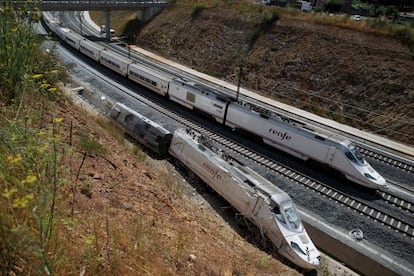Rail authorities signal 44 potential black spots in wake of Alvia disaster
Signs warning drivers of need to reduce speed installed on high-speed lines

Spain's four major high-speed railway lines have been fitted with brand new signs warning the drivers of regular trains about the stretches where they need to slow down significantly.
The move was ordered after the horrific train crash that left 79 passengers dead near Santiago de Compostela on July 24. The derailment was initially blamed on the driver, who took a turn at excess speed after apparently being distracted by a cellphone conversation with another member of the train's staff; by the time he realized he was still doing 180km/h near an upcoming bend with a limit of 80km/h, it was too late.
But the investigating judge wondered why the curve in question did not have a type of warning signal that triggers automatic breaking if the speed limit is ignored, and called in several executives from Adif, the state railway manager, to question them over safety measures.
Adif representatives claimed that Spanish train tracks have all the necessary security measures in place. This week, European Commission Transportation Commissioner Siim Kallas played down the fact that the Santiago train did not run on ERTMS, a state-of-the-art technological system that automatically controls train speeds at all times, and confirmed that it was not mandatory by EU standards. Instead, this train ran on the older ASFA system, which triggers emergency braking only if a certain speed limit is surpassed, and only if a beacon is mounted on that stretch of track.
The driver of the Santiago train had no sign warning him to slow down
But on August 31, Adif installed 44 new warning signals on its four high-speed lines running radially from Madrid to Andalusia, Valencia, Barcelona and Galicia. This type of sign was missing from the Angrois stretch.
An internal document, to which EL PAÍS has had access, shows that Adif recently ordered the installation of warning signs on all stretches of track with limits of over 160km/h and sudden speed reductions of around 40 percent.
On the other hand, not all the new warning signs come with an associated ASFA beacon that triggers emergency braking at dangerous speeds. While this system is deployed across the Spanish railway network, the high-speed AVE trains run on the newer, more sophisticated ERTMS.
The train that derailed was not an AVE, but another type of high-speed model called Alvia, which has the ability to switch between the special AVE tracks and the regular tracks elsewhere in Spain. This means that Alvias alternate between regular speeds and speeds of up to 250km/h, with decisions falling to the driver in the absence of ASFA beacons or other safety measures.
Until now, failing the presence of beacons and visual warning signs, train drivers going by those 44 spots had to make their braking decisions based on their guidebooks and their personal knowledge of the route. Francisco José Garzón, the driver of the ill-fated Santiago train, had no such sign warning him to slow down, and no beacon to do it for him when a distraction caused him to stop noticing his surroundings and take the Angrois curve at over 180km/h, even though he admitted to being perfectly familiar with it.
In his decision dated August 20, the examining judge in the case, Luis Aláez, wrote that if the train driver had been "previously and sufficiently warned" about the proximity of the Angrois curve, "it is more than likely that Francisco José would have focused on his driving again and adjusted the train's speed to the circumstances."
Judge casts wide net of responsibility
The judge seeking possible culprits for the Santiago train derailment of July 24, which killed 79 people, is aiming far beyond the train driver who admitted to be going at twice the speed limit on a sharp bend.
Senior officials and people with relevant positions at the Public Works and Finance ministries are being targeted by Luis Aláez because they sit (or recently sat) on the board of Adif, the state-owned railway infrastructure firm. Two labor union representatives who also sat on the board are under investigation.
Aláez has asked Adif for a list of all the members of the three boards corresponding to the successive chairmen of Adif (Antonio González Marín, Enrique Verdeguer and Gonzalo Ferre, all of whom could be next in line for a court inquiry) since the opening of the line where the accident occurred. The track was inaugurated in December 2012.
The list of board members has 17 names, including Alicia Portas, who was the chief of staff and right-hand aide to Public Works Minister Ana Pastor; Benigno Blanco, former state secretary for infrastructure under José María Aznar, and Julio Gómez-Pomar Rodríguez, chairman of train company Renfe and a member of the Adif board. The judge feels that all of these people had "the duty to intervene" if the heads of Adif's department of circulation security did not deploy the necessary means to prevent human error.
Meanwhile, former judge Baltasar Garzón - who gained international fame in 1998 after issuing an international arrest warrant for Chile's Augusto Pinochet and is now representing one of the Santiago crash victims - wants the investigation to target Renfe's security chief as well.







































